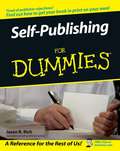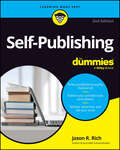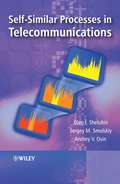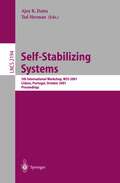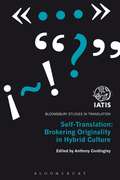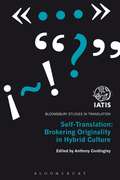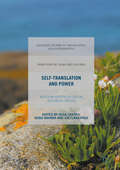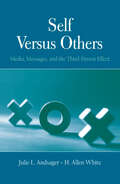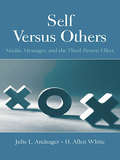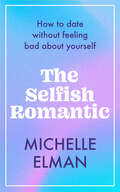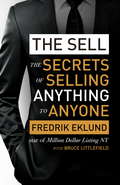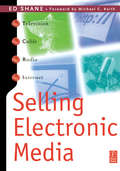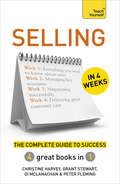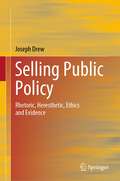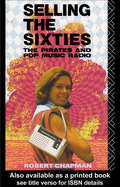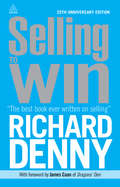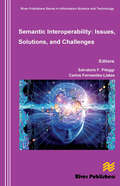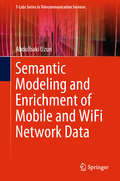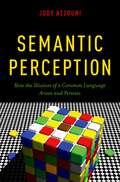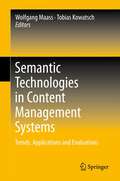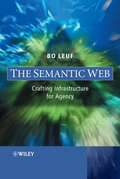- Table View
- List View
Self-Publishing For Dummies
by Jason R. RichCovers budgeting, copyrighting, and marketing Know the pros and cons of self-publishing and get your work in print Thinking about self-publishing your book? This no-nonsense guide walks you through the entire process of going it alone, from preparing your manuscript and creating the perfect title to selling the final product. You'll see how to obtain an ISBN, work with printers and distributors, create a buzz with publicity, and take advantage of electronic publishing. Discover how to * Start your own publishing company * Edit your work effectively * Design and format your book * Hire skilled professionals to help * Manage outside vendors * Build awareness for your book online
Self-Publishing For Dummies
by Jason R. RichGet your books into the hands of readers with this simple how-to guide Self-Publishing For Dummies takes you through the entire process of publishing your own books, starting with the writing and editing process and moving through cover design, printing options, distribution channels, and marketing to a target audience. With the advice in this book, you can tackle self-publishing, no matter what genre you write in. You’ll learn how to retain full control over your work and keep the profits from the sales of your book. In this updated edition, you’ll discover the latest technologies in self-publishing, trends in the world of ebooks, and new marketing techniques you can use online and in the real world. Becoming a published author is easier than ever, thanks to this Dummies guide. Understand every step in the self-publishing process Discover how to write and sell your books in ebook and printed formats Hire an editor, obtain an ISBN, and generate publicity for your book Fine-tune your writing to improve your chances of success Get your work out there—no agent or publisher neededSelf-Publishing For Dummies is the perfect choice for anyone with an interest in DIY publishing.
Self-Publishing For Dummies
by Jason R. RichGet your books into the hands of readers with this simple how-to guide Self-Publishing For Dummies takes you through the entire process of publishing your own books, starting with the writing and editing process and moving through cover design, printing options, distribution channels, and marketing to a target audience. With the advice in this book, you can tackle self-publishing, no matter what genre you write in. You’ll learn how to retain full control over your work and keep the profits from the sales of your book. In this updated edition, you’ll discover the latest technologies in self-publishing, trends in the world of ebooks, and new marketing techniques you can use online and in the real world. Becoming a published author is easier than ever, thanks to this Dummies guide. Understand every step in the self-publishing process Discover how to write and sell your books in ebook and printed formats Hire an editor, obtain an ISBN, and generate publicity for your book Fine-tune your writing to improve your chances of success Get your work out there—no agent or publisher neededSelf-Publishing For Dummies is the perfect choice for anyone with an interest in DIY publishing.
Self-Similar Processes in Telecommunications
by Oleg Sheluhin Sergey Smolskiy Andrew OsinFor the first time the problems of voice services self-similarity are discussed systematically and in detail with specific examples and illustrations. Self-Similar Processes in Telecommunications considers the self-similar (fractal and multifractal) models of telecommunication traffic and efficiency based on the assumption that its traffic has fractal or multifractal properties (is self-similar). The theoretical aspects of the most well-known traffic models demonstrating self-similar properties are discussed in detail and the comparative analysis of the different models’ efficiency for self-similar traffic is presented. This book demonstrates how to use self-similar processes for designing new telecommunications systems and optimizing existing networks so as to achieve maximum efficiency and serviceability. The approach is rooted in theory, describing the algorithms (the logical arithmetical or computational procedures that define how a task is performed) for modeling these self-similar processes. However, the language and ideas are essentially accessible for those who have a general knowledge of the subject area and the advice is highly practical: all models, problems and solutions are illustrated throughout using numerous real-world examples. Adopts a detailed, theoretical, yet broad-based and practical mathematical approach for designing and operating numerous types of telecommunications systems and networks so as to achieve maximum efficiency Places the subject in context, describing the current algorithms that make up the fractal or self-similar processes while pointing to the future development of the technology Offers a comparative analysis of the different types of self-similar process usage within the context of local area networks, wide area networks and in the modeling of video traffic and mobile communications networks Describes how mathematical models are used as a basis for building numerous types of network, including voice, audio, data, video, multimedia services and IP (Internet Protocol) telephony The book will appeal to the wide range of specialists dealing with the design and exploitation of telecommunication systems. It will be useful for the post-graduate students, lecturers and researchers connected with communication networks disciplines.
Self-Stabilizing Systems: 5th International Workshop, WSS 2001, Lisbon, Portugal, October 1-2, 2001 Proceedings (Lecture Notes in Computer Science #2194)
by Ajoy K. Datta Ted HermanPhysicalsystemswhichrightthemselvesafterbeingdisturbedevokeourcuriosity becausewe wantto understand howsuchsystemsareableto reactto unexpected stimuli. Themechanismsareallthe morefascinatingwhensystemsarecomposed of small, simple units, and the ability of the system to self-stabilize emerges out of its components. Faithful computer simulations of such physical systems exhibit the self-stabilizing property, but in the realm of computing, particularly for distributed systems, wehavegreaterambition. We imaginethat all manner of software, ranging from basic communication protocols to high-level applications, could enjoy self-corrective properties. Self-stabilizing software o?ers a unique, non-traditional approach to the c- cial problem of transient fault tolerance. Many successful instances of modern fault-tolerant networks are based on principles of self-stabilization. Surprisingly, the most widely accepted technical de?nition of a self-stabilizing system does not refer to faults: it is the property that the system can be started in any i- tial state, possibly an “illegal state,” and yet the system guarantees to behave properly in ?nite time. This, and similar de?nitions, break many traditional approaches to program design, in which the programmer by habit makes - sumptions about initial conditions. The composition of self-stabilizing systems, initially seen as a daunting challenge, has been transformed into a mana- able task, thanks to an accumulation of discoveries by many investigators. - search on various topics in self-stabilization continues to supply new methods for constructing self-stabilizing systems, determines limits and applicability of the paradigm of self-stabilization, and connects self-stabilization to related areas of fault tolerance and distributed computing.
Self-Translation: Brokering Originality in Hybrid Culture (Bloomsbury Studies in Translation)
by Anthony CordingleySelf-Translation: Brokering originality in hybridculture provides critical, historical and interdisciplinary analyses ofself-translators and their works. It investigates the challenges which thebilingual oeuvre and the experience of the self-translator pose to conventionaldefinitions of translation and the problematic dichotomies of "original" and"translation", "author" and "translator". Canonical self-translators, suchSamuel Beckett, Vladimir Nabokov and Rabindranath Tagore, are here discussed inthe context of previously overlooked self-translators, from Japan to SouthAfrica, from the Basque Country to Scotland. This book seeks therefore to offera portrait of the diverse artistic and political objectives and priorities ofself-translators by investigating different cosmopolitan, post-colonial andindigenous practices. Numerous contributions to this volume extend the scope ofself-translation to include the composition of a work out of a multilingualconsciousness or society. They demonstrate how production within hybridcontexts requires the negotiation of different languages within the self,generating powerful experiences, from crisis to liberation, and texts thatoffer key insights into our increasingly globalized culture.
Self-Translation: Brokering Originality in Hybrid Culture (Bloomsbury Studies in Translation)
by Anthony CordingleySelf-Translation: Brokering originality in hybridculture provides critical, historical and interdisciplinary analyses ofself-translators and their works. It investigates the challenges which thebilingual oeuvre and the experience of the self-translator pose to conventionaldefinitions of translation and the problematic dichotomies of "original" and"translation", "author" and "translator". Canonical self-translators, suchSamuel Beckett, Vladimir Nabokov and Rabindranath Tagore, are here discussed inthe context of previously overlooked self-translators, from Japan to SouthAfrica, from the Basque Country to Scotland. This book seeks therefore to offera portrait of the diverse artistic and political objectives and priorities ofself-translators by investigating different cosmopolitan, post-colonial andindigenous practices. Numerous contributions to this volume extend the scope ofself-translation to include the composition of a work out of a multilingualconsciousness or society. They demonstrate how production within hybridcontexts requires the negotiation of different languages within the self,generating powerful experiences, from crisis to liberation, and texts thatoffer key insights into our increasingly globalized culture.
Self-Translation and Power: Negotiating Identities in European Multilingual Contexts (Palgrave Studies in Translating and Interpreting)
by Olga Castro Sergi Mainer Svetlana PageThis book investigates the political, social, cultural and economic implications of self-translation in multilingual spaces in Europe. Engaging with the ‘power turn’ in translation studies contexts, it offers innovative perspectives on the role of self-translators as cultural and ideological mediators. The authors explore the unequal power relations and centre-periphery dichotomies of Europe’s minorised languages, literatures and cultures. They recognise that the self-translator’s double affiliation as author and translator places them in a privileged position to challenge power, to negotiate the experiences of the subaltern and colonised, and to scrutinise conflicting minorised vs. hegemonic cultural identities. Three main themes are explored in relation to self-translation: hegemony and resistance; self-minorisation and self-censorship; and collaboration, hybridisation and invisibility. This edited collection will appeal to scholars and students working on translation, transnational and postcolonial studies, and multilingual and multicultural identities.
Self Versus Others: Media, Messages, and the Third-Person Effect (Routledge Communication Series)
by Julie L. Andsager H. Allen WhiteSelf Versus Others explores the third-person effect and its role in media as a means of persuasion. This scholarly work synthesizes more than two decades of research on the third-person effect, the process in which individuals do not perceive themselves to be impacted by particular messages—such as persuaded to engage in risky behaviors or encouraged to be violent—but they believe others will be. Authors Julie L. Andsager and H. Allen White focus their analysis specifically on the role of media and media messages, and assert that the third-person effect functions as a means of persuasion. They explore the underlying concepts and connections this effect shares with established theories of persuasion and mediated communication. The only volume to date focusing on the topic, Self Versus Others demonstrates the significant impact persuasion has on public opinion, behavior, and policy. As such, understanding the means through which persuasion can be accomplished thereby provides a powerful tool. Timely and succinct, this book:*provides thorough synthesis of third-person effect literature;*argues that systematic versus heuristic processing underlies third-person perceptions; and*conceptually links third-person effects with co-orientation. Intended for communication scholars with an interest in persuasion, as well as those in key areas including mass communication, health communication, and political communication, this book is also appropriate for advanced courses in persuasion, communication theory, and campaigns.
Self Versus Others: Media, Messages, and the Third-Person Effect (Routledge Communication Series)
by Julie L. Andsager H. Allen WhiteSelf Versus Others explores the third-person effect and its role in media as a means of persuasion. This scholarly work synthesizes more than two decades of research on the third-person effect, the process in which individuals do not perceive themselves to be impacted by particular messages—such as persuaded to engage in risky behaviors or encouraged to be violent—but they believe others will be. Authors Julie L. Andsager and H. Allen White focus their analysis specifically on the role of media and media messages, and assert that the third-person effect functions as a means of persuasion. They explore the underlying concepts and connections this effect shares with established theories of persuasion and mediated communication. The only volume to date focusing on the topic, Self Versus Others demonstrates the significant impact persuasion has on public opinion, behavior, and policy. As such, understanding the means through which persuasion can be accomplished thereby provides a powerful tool. Timely and succinct, this book:*provides thorough synthesis of third-person effect literature;*argues that systematic versus heuristic processing underlies third-person perceptions; and*conceptually links third-person effects with co-orientation. Intended for communication scholars with an interest in persuasion, as well as those in key areas including mass communication, health communication, and political communication, this book is also appropriate for advanced courses in persuasion, communication theory, and campaigns.
The Selfish Romantic: How to date without feeling bad about yourself
by Michelle Elman• How many people are walking through the world convinced that they have to settle? • How many people are being treated badly because they think they don't tick desirable boxes? • What would happen if you didn't limit yourself by seeing yourself as a bunch of labels, and instead saw yourself as a catch? • How fun would it be to be single without questioning your loveability, to date without taking rejection personally, and to have sex without hating your body?Nearly every question life coach and queen of boundaries Michelle Elman is asked relates to one subject: dating.Including unravelling myths about single life, changing your dating mindset, dealing with ghosting, text etiquette and taking relationships offline, The Selfish Romantic will teach you how to empower your love life like never before.Combining Michelle's expertise in boundaries and body positivity, this is your guide to navigating the modern dating landscape.
The Sell: The secrets of selling anything to anyone
by Bruce Littlefield Fredrik EklundTen years ago, Fredrik Eklund moved to New York City from his native Sweden with nothing but a worn-out pair of sneakers and a dream: to make it big in the city that never sleeps. Despite having no experience in real estate and no contacts, Fredrik transformed himself into the best seller in the most competitive real estate market on the planet, brokering multimillion-dollar deals for celebrities, selling out properties all over the city and charming TV audiences as one of the stars of Million Dollar Listing New York.In The Sell, Fredrik shares his secrets so that anyone can find success doing what they love. According to Fredrik, even if you don't consider yourself a salesperson, you've been in sales your whole life because every day you are selling your most important asset: yourself. Whenever you influence or persuade someone to give you something in exchange for what you've got - whether it's a luxury home, a great idea at work, or your profile on Match.com - you are selling. And if you know how to sell right, you can live your dream.Blending personal stories and the expertise he's gained from his meteoric rise, The Sell is the modern guide to becoming successful. Featuring everything from the importance of intangible factors like personality and charm, to tips and tricks for preparing, persuading and negotiating, The Sell is a vital go-to book for anyone who wants to have an impact in his or her personal and professional life. No matter what your background is - sales rep, CEO or kitchen-table entrepreneur - this book will help you sell yourself or your brand, and lead a richer, more fulfilling life.
Selling Electronic Media
by Ed Shane"Selling is identifying and satisfying customer needs profitably. Profitable for you, profitable for them."Diane Sutter, President and CEO of Shooting Star Broadcasting , owner of KTAB-TV, Abilene, TexasThis is the definition of sales used throughout Ed Shane's comprehensive and timely textbook Selling Electronic Media. This new definition reflects the customer-orientation of today's marketing environment as well as the product-orientation of selling. Today's selling is a win/win proposition, a win for the seller and a win for the customer.Using interviews with industry leaders and reports of their selling experiences, Selling Electronic Media shares insight and practical advice in the basics of selling: · prospecting· qualifying· needs analysis· presentations· answering objections· closing· relationship management Focusing on the merging and converging of electronic media and the need for branding of media at all levels, this highly readable book offers complete coverage of advertising sales for radio, television and cable, plus the new and emerging mass communication technologies, primarily those generated by the Internet.Selling Electronic Media is enhanced with review highlights and discussion points and illustrated throughout with visuals used by media outlets to market commercials and their audience reach.Students pursuing sales and marketing careers in electronic media and professionals wishing to reinforce their understanding of the merging and converging media environment will find what they need in the pages of this book.
Selling Electronic Media
by Ed Shane"Selling is identifying and satisfying customer needs profitably. Profitable for you, profitable for them."Diane Sutter, President and CEO of Shooting Star Broadcasting , owner of KTAB-TV, Abilene, TexasThis is the definition of sales used throughout Ed Shane's comprehensive and timely textbook Selling Electronic Media. This new definition reflects the customer-orientation of today's marketing environment as well as the product-orientation of selling. Today's selling is a win/win proposition, a win for the seller and a win for the customer.Using interviews with industry leaders and reports of their selling experiences, Selling Electronic Media shares insight and practical advice in the basics of selling: · prospecting· qualifying· needs analysis· presentations· answering objections· closing· relationship management Focusing on the merging and converging of electronic media and the need for branding of media at all levels, this highly readable book offers complete coverage of advertising sales for radio, television and cable, plus the new and emerging mass communication technologies, primarily those generated by the Internet.Selling Electronic Media is enhanced with review highlights and discussion points and illustrated throughout with visuals used by media outlets to market commercials and their audience reach.Students pursuing sales and marketing careers in electronic media and professionals wishing to reinforce their understanding of the merging and converging media environment will find what they need in the pages of this book.
Selling in 4 Weeks: The Complete Guide to Success: Teach Yourself
by Peter Fleming Christine Harvey Grant Stewart Di McLanachanSelling In 4 Weeks is a comprehensive guide to sales, giving you everything you need to know in one place. Made up of four bestselling books in one, this book delivers a complete course in selling. From strategy and account management to negotiation and customer service you'll discover all the tools, techniques and strategies you need to get your selling right.This book introduces you to the main themes and ideas of sales, giving you a knowledge and understanding of the key concepts, together with practical and thought-provoking exercises. Whether you choose to work through it like a 4 week course or dip in and out, Selling In 4 Weeks is your fastest route to success:Week 1: Successful Selling In A WeekWeek 2: Successful Key Account Management In A WeekWeek 3: Successful Negotiating In A WeekWeek 4: Successful Customer Care In A WeekABOUT THE SERIESIn A Week books are for managers, leaders, and business executives who want to succeed at work. From negotiating and content marketing to finance and social media, the In A Week series covers the business topics that really matter and that will help you make a difference today. Written in straightforward English, each book is structured as a seven-day course so that with just a little work each day, you will quickly master the subject. In a fast-changing world, this series enables readers not just to get up to speed, but to get ahead.
Selling Public Policy: Rhetoric, Heresthetic, Ethics and Evidence
by Joseph DrewProfessor Drew’s latest work makes the case that even great public policy needs to be deliberately and strategically sold in order for it to ultimately be considered a success. However, it seems that most people charged with the task of selling public policy simply do not have the requisite skills to do so.Selling public policy is an art that draws on disparate strands of scholarship spanning the political sciences, economics, sociology, ethics and the classics. To perform the art of selling public policy one must first master the lessons from the greats in the field. Following this, it is necessary to learn how to apply the knowledge to real-world complex scenarios in such a way that the policy is indeed sold and stays sold over the implied returns period.This book is unique in the corpus of scholarly literature because it provides both the knowledge and real-world case studies required for students, scholars, and policy practitioners to master the art of selling public policy.
Selling the Sixties: The Pirates and Pop Music Radio
by Robert ChapmanWas it a non-stop psychedelic party or was there more to pirate radio in the sixties than hedonism and hip radicalism? From Kenny Everett's sacking to John Peel's legendary `Perfumed Garden' show, to the influence of the multi-national ad agencies, and the eventual assimilationof aspects of unofficial pop radio into Radio One, Selling the Sixties examines the boom of private broadcasting in Britain. Using two contrasting models of pop piracy, Radios Caroline and London, Robert Chapman sets pirate radio in its social and cultural context. In doing so he challenges the myths surrounding its maverick `Kings Road' image, separating populist consumerism from the economic and political machinations which were the flipside of the pirate phenomenon. Selling the Sixties includes previously unseen evidence from the pirates' archives, revealing interviews and an unrivalled selection of rare audio materials.
Selling the Sixties: The Pirates and Pop Music Radio
by Robert ChapmanWas it a non-stop psychedelic party or was there more to pirate radio in the sixties than hedonism and hip radicalism? From Kenny Everett's sacking to John Peel's legendary `Perfumed Garden' show, to the influence of the multi-national ad agencies, and the eventual assimilationof aspects of unofficial pop radio into Radio One, Selling the Sixties examines the boom of private broadcasting in Britain. Using two contrasting models of pop piracy, Radios Caroline and London, Robert Chapman sets pirate radio in its social and cultural context. In doing so he challenges the myths surrounding its maverick `Kings Road' image, separating populist consumerism from the economic and political machinations which were the flipside of the pirate phenomenon. Selling the Sixties includes previously unseen evidence from the pirates' archives, revealing interviews and an unrivalled selection of rare audio materials.
Selling to Win: Tested Techniques For Closing The Sale (Marketing And Sales Ser.)
by Richard DennyRecognized internationally as one of the most effective sales improvement guides ever written, Selling to Win is an invaluable text for sales and marketing professionals. It explains clearly how to put winning techniques into action, featuring advice on getting a sale despite not being the cheapest, turning a customer into an ambassador, building a positive attitude that gets results, beating the competition and closing a sale. This 25th anniversary edition of Selling to Win has been revised and is full of even more sales tips and essential practical advice. With a foreword from James Caan, successful entrepreneur, author and former investor on BBC's Dragon's Den, it has been updated to reflect current selling techniques and includes success stories from readers of the previous editions who applied what they learned in the book.
Semantic Interoperability Issues, Solutions, Challenges
by Salvatore F. Pileggi Carlos Fernandez-LlatasSemantic technologies are experimenting an increasing popularity in the context of different domains and applications. The understanding of any class of system can be significantly changed under the assumption any system is part of a global ecosystem known as Semantic Web.The Semantic Web would be an evolving extension of current Web model (normally referred as Syntactic Web) that introduces a semantic layer in which semantics, or meaning of information, are formally defined.So, semantics should integrate web-centric standard information infrastructures improving several aspects of interaction among heterogeneous systems. This is because common interoperability models are progressively becoming obsolete if compared with the intrinsic complexity and always more distributed focus that feature modern systems. For example, the basic interoperability model, that assumes the interchange of messages among systems without any interpretation, is simple but effective only in the context of close environments. Also more advanced models, such as the functional interoperability model that integrates basic interoperability model with the ability of intepretating data context under the assumption of a shared schema for data fields accessing, appears not able to provide a full sustainable technologic support for open systems.The Semantic Interoperability model would improve common interoperability models introducing the interpretation of means of data. Semantic interoperability is a concretely applicable interaction model under the assumption of adopting rich data models (commonly called Ontology) composed of concepts within a domain and the relationships among those concepts.In practice, semantic technologies are partially inverting the common view at actor intelligence: intelligence is not implemented (only) by actors but it is implicitly resident in the knowledge model. In other words, schemas contain information and the "code" to interpretate it.
Semantic Interoperability Issues, Solutions, Challenges
Semantic technologies are experimenting an increasing popularity in the context of different domains and applications. The understanding of any class of system can be significantly changed under the assumption any system is part of a global ecosystem known as Semantic Web.The Semantic Web would be an evolving extension of current Web model (normally referred as Syntactic Web) that introduces a semantic layer in which semantics, or meaning of information, are formally defined.So, semantics should integrate web-centric standard information infrastructures improving several aspects of interaction among heterogeneous systems. This is because common interoperability models are progressively becoming obsolete if compared with the intrinsic complexity and always more distributed focus that feature modern systems. For example, the basic interoperability model, that assumes the interchange of messages among systems without any interpretation, is simple but effective only in the context of close environments. Also more advanced models, such as the functional interoperability model that integrates basic interoperability model with the ability of intepretating data context under the assumption of a shared schema for data fields accessing, appears not able to provide a full sustainable technologic support for open systems.The Semantic Interoperability model would improve common interoperability models introducing the interpretation of means of data. Semantic interoperability is a concretely applicable interaction model under the assumption of adopting rich data models (commonly called Ontology) composed of concepts within a domain and the relationships among those concepts.In practice, semantic technologies are partially inverting the common view at actor intelligence: intelligence is not implemented (only) by actors but it is implicitly resident in the knowledge model. In other words, schemas contain information and the "code" to interpretate it.
Semantic Modeling and Enrichment of Mobile and WiFi Network Data (T-Labs Series in Telecommunication Services)
by Abdulbaki UzunThis book discusses the fusion of mobile and WiFi network data with semantic technologies and diverse context sources for offering semantically enriched context-aware services in the telecommunications domain.It presents the OpenMobileNetwork as a platform for providing estimated and semantically enriched mobile and WiFi network topology data using the principles of Linked Data. This platform is based on the OpenMobileNetwork Ontology consisting of a set of network context ontology facets that describe mobile network cells as well as WiFi access points from a topological perspective and geographically relate their coverage areas to other context sources.The book also introduces Linked Crowdsourced Data and its corresponding Context Data Cloud Ontology, which is a crowdsourced dataset combining static location data with dynamic context information. Linked Crowdsourced Data supports the OpenMobileNetwork by providing the necessary context data richness for more sophisticated semantically enriched context-aware services.Various application scenarios and proof of concept services as well as two separate evaluations are part of the book. As the usability of the provided services closely depends on the quality of the approximated network topologies, it compares the estimated positions for mobile network cells within the OpenMobileNetwork to a small set of real-world cell positions. The results prove that context-aware services based on the OpenMobileNetwork rely on a solid and accurate network topology dataset. The book also evaluates the performance of the exemplary Semantic Tracking as well as Semantic Geocoding services, verifying the applicability and added value of semantically enriched mobile and WiFi network data.
Semantic Technologies in Content Management Systems: Trends, Applications and Evaluations
by Wolfgang Maass Tobias KowatschContent Management Systems (CMSs) are used in almost every industry by millions of end-user organizations. In contrast to the 90s, they are no longer used as isolated applications in one organization but they support critical core operations in business ecosystems. Content management today is more interactive and more integrative: interactive because end-users are increasingly content creators themselves and integrative because content elements can be embedded into various other applications. The authors of this book investigate how Semantic Technologies can increase interactivity and integration capabilities of CMSs and discuss their business value to millions of end-user organizations. This book has therefore the objective, to reflect existing applications as well as to discuss and present new applications for CMSs that use Semantic Technologies. An evaluation of 27 CMSs concludes this book and provides a basis for IT executives that plan to adopt or replace a CMS in the near future.
The Semantic Web: Crafting Infrastructure for Agency
by Bo LeufThe Semantic Web is an idea of World Wide Web inventor Tim Berners-Lee that the Web as a whole can be made more intelligent and perhaps even intuitive about how to serve a users needs. Although search engines index much of the Web's content, they have little ability to select the pages that a user really wants or needs. Berners-Lee foresees a number of ways in which developers and authors, singly or in collaborations, can use self-descriptions and other techniques so that the context-understanding programs can selectively find what users want. The Semantic Web: Crafting Infrastructure for Agency presents a more holistic view of the current state of development and deployment. This a comprehensive reference to the rapidly developing technologies, which are enabling more intelligent and automated transactions over the internet, and a visionary overview of the implications of deploying such a layer of infrastructure. A through examination of the Semantic Web, including the following topics: web information management, languages and protocols, application and tools, and collaboration and agency. A unique volume of practical information, in-depth analysis, conceptual overviews and contextual material from professionals in the field. Features appendices of technical terms and glossary, Semantic Web resources, intellectual property issues and lists of elements. This is essential reading for engineers, web developers and industry professionals wishing to enhance their knowledge of recent developments. Management staff, lecturers. postgraduate and undergraduate students will also find this book appealing.
